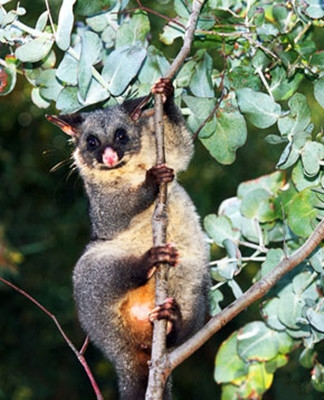(单词翻译:单击)
中英文本
Science and technology
科学技术
Animal behaviour
动物行为
Drip-feeding
滴定进食
Ecology raids the techniques of chemistry
生态学里应用上了化学技术。
Time to change restaurant
该换家馆子了。
BIOLOGISTS are sometimes accused of physics envy—and there is truth in this accusation.
生物学家们常常被认为非常嫉妒研究物理学的人。
The essential fuzziness of biological systems can never be captured by the precise, mathematically based experiments of something like the Large Hadron Collider.
他们永远不可能通过像大型强子加速碰撞那样精确、量化的实验来揭示生物学里的一些关键性的奥秘。
Between physics and biology on the spectrum of fuzziness, though, lies chemistry.
但是在这种奥秘的“两极”—物理学和生物学之间还有化学。

And a group of researchers led by Carolyn Nersesian of the University of Sydney has just borrowed one of chemistry’s most elegant techniques, titration, to answer a pressing ecological question: how do animals choose where to feed?
最近由悉尼大学的卡洛琳·涅尔谢相带领的一组研究人员借用化学里一种非常精妙的技术—滴定法来解决一个迫待回答的问题:动物们如何选择觅食场所。
Titration, to remind those who dozed through their chemistry lessons, is a way of working out the concentration of a substance in a solution.
滴定法是一种计算溶质在溶液中的浓度的方法。
A reagent of known concentration is dripped into the unknown solution in the presence of an appropriate indicator molecule.
在某种特定的指示分子的参与下,将一种已知浓度的溶液滴到未知溶液中。
When the tipping point comes, and all of the unknown reagent has reacted, the solution changes colour.
当滴定终点到来时,所有的未知溶液全都完成了化学反应,溶液的颜色就会发生变化。
The unknown concentration can then be calculated from the amount of known reagent used.
然后未知溶液的浓度就可以通过被消耗掉的已知溶液的体积计算出来。
In Dr Nersesian’s titration the litmus was a species called the brushtail possum. The two reagents were predators and poisons.
涅尔谢相博士的滴定实验中的“石蕊指示剂”是一种叫帚尾袋貂的动物。那两种溶液是“猎食者”和“有毒物”。
In the wild, possums feed mainly on eucalyptus trees.
在野生环境下,袋貂主要以桉树叶为食。
Feeding in trees this way also keeps them safe from ground-based predators, such as foxes.
生活在树上也能让它们安全地远离地面上的那些猎食者—例如狐狸。
They frequently have to shift from tree to tree in search of non-poisonous leaves, though, because a tree that is being browsed starts manufacturing toxins.
但是他们还得经常从一棵树上换到另一棵树上去寻找那些没有毒的叶子。因为一颗树如果被它们吃久了就会自动分泌毒素。
Dr Nersesian reasoned that there is probably a measurable point at which a plant becomes so toxic that possums prefer to take their chances with the predators on the ground—and she realised this was a perfect opportunity to do an ecological titration.
涅尔谢相博士认为可能当植物中的毒素达到一个量值的时候,袋貂会选择冒着被猎食的风险,然后她就意识到这是一个应用生态滴定法绝好的机会。
As she reports in the Journal of Animal Ecology, she attempted to imitate the distinction between trees and ground by giving eight possums the opportunity to feed in either of two enclosures.
她发表在动物生态学报上报告中写道:她通过给8只袋貂两种桉树来选择觅食来模拟树上和地面的区别。
In one, cover was created with eucalyptus branches and light levels were kept low, mimicking an arboreal habitat.
一棵桉树上,有特意放置的桉树枝来遮挡,光照强度也很低,模拟出适合树栖动物习性的环境。
Here, the food was sometimes spiked with cineole—a poison often found in eucalyptus leaves.
但是,这种树上的叶子有时含有桉树脑—桉树叶中常见的毒素。
In the other enclosure, the food was always untarnished.
另一棵桉树上,叶子总是无毒的,但是,没有树枝的遮挡。
However, no cover was provided and fox scent, in the form of faeces and urine, was scattered liberally around, mimicking conditions on the ground.
而且通过将一些狐狸的“踪迹”,例如狐狸的脸谱尿液随意四散在周围,来模拟地面环境。
To start with, when the level of cineole was low, possums preferred the first enclosure.
开始桉树脑的浓度很低,袋貂都喜欢第一棵桉树。
But as the drip of the titration went up, from 0% to 1% to 2% to 5% and ultimately to 10% of the food being cineole, their behaviour changed.
但是随着滴定程度的上升,食物中的桉树脑含量从0%到1%到2%到5% 到最终的10%,它们的行为开始出现变化。
It was not quite the sudden shift from litmus red to blue of an acid being neutralised by an alkali, but it was not far off.
虽然不是完全像酸溶液完全被碱溶液中和时石蕊试剂突然从红变蓝那样迅速,但是也差不太多。
When the food was toxin-free, the possums spent an average of 40 minutes of every hour eating safely under treelike cover and only 20 minutes in the risky, ground-like enclosure, and that scarcely changed for 1% and 2% cineole.
当叶子无毒时,袋貂们每小时用平均40分钟的时间在树枝状的遮蔽物下安全的进食。而在危险的类地面的桉树上只待20分钟,这时的桉树脑含量变化在1%到2%之间。
The switch began at 5%, and by the time the cineole level had reached 10% the ratio of time the animals spent in the two enclosures had reversed itself—presumably reflecting, though this remains to be tested, the point at which they change trees in the wild.
分界点出现在5%,当桉树脑含量达到10%,这些小动物们呆在这两颗桉树上的时间比完全颠倒过来了——这大致上能反映在野外环境下它们换树进食时的毒素量值,当然这还有待验证。
Though foxes are of recent introduction in Australia, many marsupial predators, now extinct, were present before the arrival of man in both his Aboriginal and his European forms, so the ecological system of plants, herbivores and carnivores in the eucalyptus forests would probably not have been that different in the evolutionary past.
虽然狐狸是很晚才被引进到澳大利亚的,但是在原始人或者欧洲人到来之前还有很多其他的有袋动物的猎食者。所以桉树林生态系统中的那些植物,素食动物肉食动物,与进化史中较早的生态系统相比,差别可能也没有那么大。
A neat illustration, then, of co-evolution between three different parts of an ecosystem—and of the value, even in biology, of precise measurement.
这样一来生态系统中的三个不同角色的协同进化的一张清晰的图表呈现出来。在生物学里也能进行精确的量化计算,这种尝试的价值是巨大的。
词语解释
1.behaviour n.行为;举止
Such behaviour is beneath contempt.
这种行为令人不齿。
2.accusation n.控告;指控
His father was under an accusation then.
他父亲当时受到控告。
3.experiment n.试验;实验
The researchers are repeating the experiment on rats.
研究人员用老鼠反覆做该试验。
4.elegant a.优雅的;雅致的
He strolled about, looking very debonair in his elegant new suit.
他穿了一身讲究的新衣服逛来逛去,显得颇为惬意。
5.chemistry n.化学
I prefer chemistry to physics.
我喜欢化学甚于物理。


